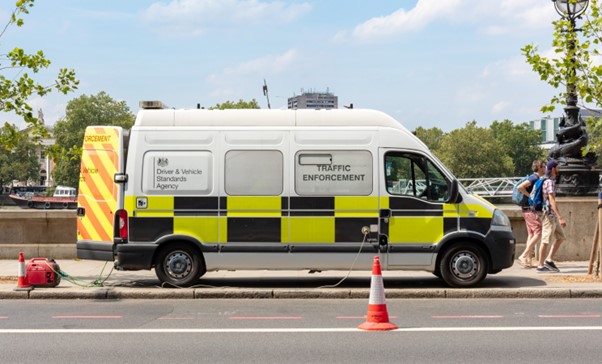
Susie Jones
Explicación de los controles de la DVSA para vehículos pesados
Creado: 08/08/2024
•
Actualizado: 08/08/2024
A lo largo de su carrera como conductor de camiones, es posible que la Agencia de Normas para Conductores y Vehículos (DVSA) le detenga. Para los camioneros nuevos en el sector, puede ser un proceso desalentador. Sin embargo, comprender los aspectos esenciales de los controles de camiones de la DVSA puede hacer que el proceso sea menos estresante.
¿Quién es la DVSA?
Según Gov.uk, la DVSA se encarga de "realizar controles en carretera a conductores y vehículos comerciales para asegurarse de que cumplen las normas de seguridad y de que su vehículo es seguro para conducir."
La DVSA puede realizar controles aleatorios de su camión y expedir prohibiciones. Las prohibiciones impiden que un conductor de camión conduzca hasta que se resuelva el problema con su vehículo.
La policía también tiene autoridad para detener a un camionero y realizar controles similares.
¿Cómo son los examinadores de la DVSA?
Hay varias formas de identificar a un examinador de la DVSA. Llevarán chaquetas amarillas de visibilidad con el logotipo de la DVSA y siempre una tarjeta de autorización. Sus vehículos llevan un estampado negro y amarillo con el logotipo de la DVSA en el capó.

¿Qué ocurre si te paran?
No detenerse cuando se lo pide un examinador de la DVSA es una infracción. Si un examinador le pide que se detenga, realizará el control en el arcén o en un centro de inspección específico. El objetivo principal de estas paradas es mantener los vehículos peligrosos fuera de la carretera.
Un examinador realizará las siguientes comprobaciones obligatorias:
Comprobación del peso de la carga autorizada y del tipo de carga
Comprobación de fallos mecánicos y aptitud para la circulación
Garantizar que los registros del tacógrafo son correctos
Asegúrate de que tienes un permiso de conducir válido.
¿Cuánto dura un control de la DVSA?
Por término medio, una inspección de la DVSA dura 15 minutos. Sin embargo, en los casos en que el camión no cumpla los requisitos de seguridad, puede llevar más tiempo. El examinador debe realizar las comprobaciones necesarias, independientemente del tiempo.
Cómo asegurarse de que su vehículo está en condiciones de circular
Es responsabilidad del conductor asegurarse de que su camión está en condiciones de circular. Se recomienda realizar una revisión antes de cada viaje.
Compruebe los siguientes elementos:
Luces
Indicadores
Combustible y aceite
Neumáticos
Fijaciones de rueda
Carrocería
Acoplamiento del remolque
Carga y otros equipos
Comprobaciones del vehículo en cabina (por ejemplo, cinturones de seguridad, claxon, limpiaparabrisas, lavaparabrisas, dirección e indicador de altura).
Además, es responsabilidad del camionero informar por escrito a su organización de cualquier defecto. Deberá incluir lo siguiente:
Matrícula del vehículo o marca de identificación
Fecha de la inspección
Detalles de los defectos
Nombre de la persona que comunica los defectos.
Responsabilidades del operador
Los operadores de vehículos son responsables de garantizar la seguridad de sus vehículos y deben llevar a cabo lo siguiente:
El operador debe garantizar que todos los vehículos comerciales se someten a inspecciones de seguridad periódicas.
Deben asegurarse de que sus conductores entienden qué controles deben realizarse.
Prohibiciones de circulación
Si su camión no está en condiciones de circular, la DVSA puede expedirle dos notificaciones de prohibición diferentes: inmediata o diferida.
Aviso de prohibición inmediata:
Puede entrar en vigor inmediatamente
En la mayoría de los casos, provocará la inmovilización del vehículo
Las prohibiciones inmediatas pueden dar lugar a un procesamiento.
Notificación de prohibición diferida:
El operador tiene hasta 10 días para resolver los problemas
Después de diez días, los agentes volverán a inspeccionar el vehículo
Las prohibiciones deben eliminarse antes de que el camión pueda circular.
Prohibiciones de circulación
Si el camión tiene problemas mecánicos o la carrocería y el equipamiento son de mala calidad, se impone una prohibición de circulación. Para los vehículos de fuera del Reino Unido, el conductor recibirá una prohibición inmediata. Para los operadores del Reino Unido, el tipo de prohibición dependerá de la gravedad del defecto.
Defectos menores:
Los defectos menores pueden dar lugar a una prohibición diferida
El operador tendrá hasta diez días para resolver cualquier defecto
A los diez días se realizará una nueva inspección.
Defectos graves:
El conductor recibirá una prohibición marcada con una "S" por defecto grave
Una prohibición marcada con una "S" se produce cuando hay un problema de mantenimiento
Si el examinador decide que no existe un riesgo inmediato, pueden aplazarse las prohibiciones
El vehículo será inmovilizado y usted podría ser procesado.
Una prohibición marcada con una 'S' no se producirá para lo siguiente:
Si surge algún problema durante el viaje
No se ha podido detectar el problema (por ejemplo, un defecto en la parte inferior).

Prohibiciones de sobrecarga
Si el vehículo está sobrecargado, un examinador de la DVSA puede inmovilizarlo. Alternativamente, el examinador puede dirigir el camión a un lugar cercano donde se pueda redistribuir o retirar la carga. El operador del vehículo recibirá un aviso.
Prohibiciones de horas del conductor
Los conductores que no respeten las normas sobre el tacógrafo y las horas de conducción recibirán una prohibición. Hacerlo puede acarrear una multa, un proceso judicial o la inmovilización del vehículo.
Más información sobre normas y reglamentos sobre tacógrafos
Aunque los exámenes de la DVSA pueden ser una perspectiva desalentadora para los conductores de camiones, es innegable que constituyen una fuerza positiva para la seguridad vial. Si te aseguras de que llevas a cabo las comprobaciones correctas y sigues las normas y reglamentos esenciales, el examen de la DVSA te saldrá redondo.
¿Cuánto tiempo debe conservar las hojas de defectos de los camiones?
La implantación de un sistema de notificación de defectos nulos puede ser su primera línea de defensa a la hora de demostrar que sus vehículos están en condiciones de circular. Los trabajos de rectificación de defectos deben notificarse y conservarse durante un máximo de 15 meses. Cuando no haya defectos, la empresa debe mantener registros para garantizar que los conductores realizan sus comprobaciones.
¿Con qué frecuencia necesita un reconocimiento médico para conservar el carné?
Para obtener y mantener una licencia HGV, es obligatorio realizar un examen médico HGV - sin esto, no se le expedirá una licencia.
Para los conductores menores de 45 años, el reconocimiento médico durará hasta que cumplan 45 años. Sin embargo, después de esta edad, deberá pasar el reconocimiento médico cada cinco años hasta los 65 años. Los conductores de 65 años o más deberán pasar la evaluación médica cada año.



